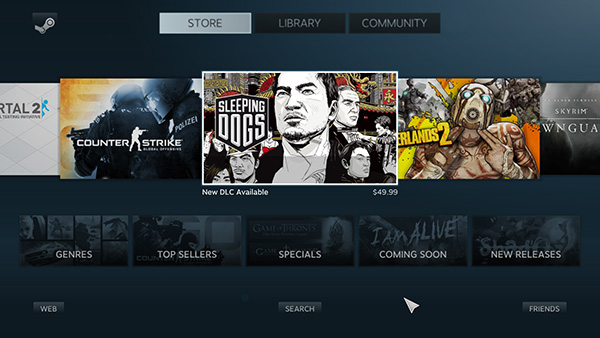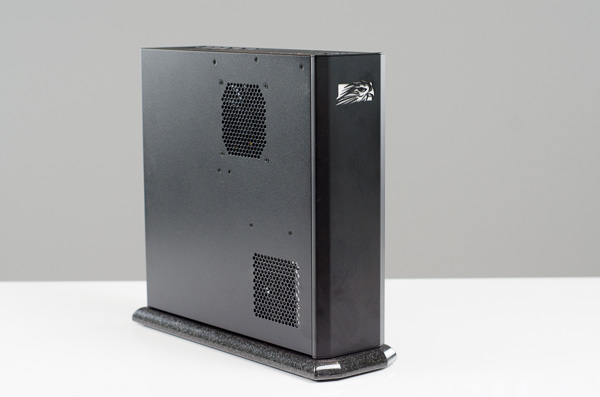High-End Meets Small Form Factor: GeForce Titan in Falcon Northwest's Tiki
by Anand Lal Shimpi on February 19, 2013 9:00 AM ESTA Console-Like Experience
Obviously a big selling point of NVIDIA's GeForce Titan is the ability to deliver a ton of performance in a single card configuration. While we can't get to performance specifics until Thursday, I can talk about the experience a bit.
The Tiki's form factor really did a great job approximating a gaming console, while offering the performance, quality and flexibility you get with a gaming PC. I used this little experiment as an opportunity to play around with Steam's Big Picture mode, a 10-foot-UI designed to be navigated via a wireless controller while your PC is connected to a TV. When combined with the Tiki's small form factor, the experience was actually pretty striking. There are really two elements to Steam's Big Picture mode enabling a console-like PC gaming experience. The first is simply the user interface. Big Picture is extremely quick, and just so much better than the sluggish mess that is the Xbox 360's UI today. It doesn't hurt that it's being driven by a 4.6GHz Core i7 in this case, which brings me to the next point. The combination of Intel's Core i7 with NVIDIA's GeForce Titan, in the Tiki's console-like chassis, resulted in a system that could run pretty much anything I threw at it without flinching.
With the exception of games like Far Cry 3, everything ran so very fast and smooth on the system with every setting cranked all the way up (sometimes set unreasonably high). In these cases the setup might as well have been a console, everything just worked, ran smoothly and loaded quickly. It's the FC3s and Crysis 3s of the world that will still require that you be reasonable with your quality settings, at least if you're running at 1080p or 2560 x 1440 (mostly by keeping AA disabled, you can leave the quality settings turned way up). Even taking into account the titles that can stress a single 7.1B transistor GPU, the overall experience is still very good.
While Steam's Big Picture mode does still have some rough edges, it really does enable a very console-like experience. It's obvious to me that Valve has a real path towards building an open console platform around PC hardware. I can't stress how much the Tiki's small form factor really added to the illusion of gaming on a console. It's all really well done.
Power Consumption & Noise
My perspective on what's considered quiet has been sort of warped by the fact that for the past two months I've been using a 27-inch iMac as my primary system. While the upgraded 27-inch iMac is a surprisingly potent gaming system for an all-in-one, the Tiki is in a completely different class of performance. The Titan equipped Tiki idled at 40.5dB(A), measured a foot in front of the chassis. Under heavy GPU load, I measured 42.6dB(A) at the same spot (with the system off I measured 33.0dB(A)). The system isn't silent by any means, but it's not loud either. You hear a lot of air movement (as well as the Asetek cooler pumping its liquid around from time to time), but not much else. The days of a high end gaming rig being obnoxiously loud are thankfully over.
At idle the Tiki benefits from tons of power gating on the two big consumers in the system (Intel's Core i7 and NVIDIA's GF Titan), my test system only drew 50.5W at the wall - that's actually less power than a slim Xbox 360 at idle. Under load it's a different story however. The Titan equipped Tiki pulled a peak of 323.5W, but sustained power consumption with a GPU heavy workload was 286.5W.












33 Comments
View All Comments
Aikouka - Tuesday, February 19, 2013 - link
I wanted to add one thing to your comparison between the Tiki and the 360 that I think makes it even more interesting: the power supply. It's pretty easy to forget given we don't necessarily consider it, but if they stuffed the power supply into the 360, it would probably come even closer to the size of the Tiki.As for Steam's Big Picture Mode (BPM), what I would love to see is better thought to the user experience. I use BPM on my Gaming HTPC along with Windows Media Center (for the superior CableCard-based tuner support). Well, the problem is that there isn't an easy way to cycle between the two pieces of software. The biggest problem is that when you exit BPM, it doesn't actually exit Steam, which can be a good thing since logging into Steam takes an absurdly long time. However, that means that you can't use a piece of software to track when Steam closes and have it reopen WMC. There's a piece of software like that which allows for switching to XBMC from within WMC.
lmcd - Tuesday, February 19, 2013 - link
Or Big Picture could just load in video plug-ins, and handle content management. Since Valve is in digital distribution I could see them teaming up with 7digital or someone to get themselves a store.cjs150 - Tuesday, February 19, 2013 - link
NVidia please produce a watercooled version! That + an i7-3770k in a Silverstone TJ08 with a 200x200mm radiator would produce a quiet, cool and super powerful system.Very impressed with how little power needed to run that system.
Only problem for me is that the GPU is way too powerful for my needs. I havent yet moved up to 1920x1080 monitor.
Falcon sure builds pretty systems
Gigaplex - Tuesday, February 19, 2013 - link
Why would NVIDIA build a watercooled version? They pretty much just build a reference platform and sell chips, it's the OEMs that do custom cooling solutions.alpha754293 - Tuesday, February 19, 2013 - link
What kind/type/speed and how much RAM is in the system that you reviewed here?mavere - Tuesday, February 19, 2013 - link
"My perspective on what's considered quiet has been sort of warped by the fact that for the past two months I've been using a 27-inch iMac as my primary system."Uhhh I get the sense that you're trying to qualify your perspective on system noise somehow, but I don't think iMacs, especially the 27" ones, are mass-market enough to be used as a general reference point.
Can you rephrase and/or link to a review? Thanks.
chizow - Tuesday, February 19, 2013 - link
Eh....don't think so. There's nothing in there that would justify that price point, it makes Alienware's X-51 seem like a steal. And the X-51 looks much nicer to boot.I do like the innovation with the daughter/riser card accomodating a full-sized GPU. Now that the cat is out of the bag on that one however, I expect more OEMs to follow suit, albeit at a much cheaper price tag. $1k + $300 for a GTX 670 would be a very attractive option, imo, and make up for the lack of grunt on the X-51's GPU options.
JonnyDough - Wednesday, February 20, 2013 - link
I'd rather have the IO Sheild/Backpanel at the top of the case, rather than the bottom for the exact reason you listed Anand. You can see it better when plugging in peripherals.The PSU and video card connections can be at the bottom. Plus, your mouse cord might be too short to accommodate your desk. You just never know.
brucek2 - Wednesday, February 20, 2013 - link
I'm surprised there were 1080p settings for Far Cry 3 that this system couldn't play. If this system can't do it... what system were they targeting?!? I guess its nice that game looks to future hardware improvements but targeting a level of hardware power that's significantly above this system seems like a very large gap.marc1000 - Wednesday, March 6, 2013 - link
it's nice to see that BOTH fans are intakes on this small chassis. they are also made by scythe. I wonder where is the PSU air output, but anyway for thermals this is a great design. the only problem would be how to block dust from entering the system.